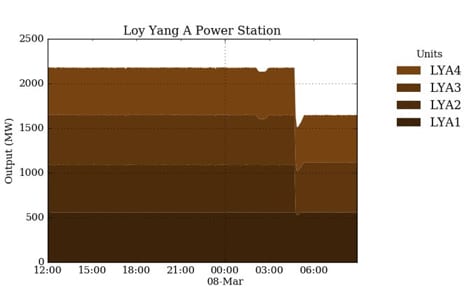If the federal Coalition wants to turn to Australia’s ageing coal plants for reliability, let’s hope they know where to find some decent back-up.
Earlier Thursday morning, two of the country’s biggest coal units – 530MW blocks at the Loy Yang A (number two) and the Loy Yang B (number 1) brown coal generators – tripped at the same time, robbing the grid of 1,065MW of capacity in an instant.


There is no indication yet of what caused the outage – although it seems that the Loy Yang B unit tripped, causing power surge which took out the number two unit at Loy Yang A. There is talk that the Loy Yang B unit will be out for a month, so it is relatively serious.
At least they didn’t fail in the midst of a heatwave. As it turned out, demand was low (but growing as the population slowly awakened and switched stuff on).
However, the outage did cause prices to double in Victoria as traders profited from the sudden scarcity, with the same impact passed on to South Australia’s electricity market, and to a lesser extent in NSW.
These are the 43rd and 44th trip of a major coal-fired unit in the Australian grid since the start of summer, according to The Australia’s Institute Coal and Gas Watch. Seven have occurred in March alone.
And they were the 12th and 13th suffered since Christmas by big brown coal generators, making a mockery of the federal government’s focus on coal-fired generation as a guarantor of “reliability”.
Wind and solar are criticised by the country’s energy minister Josh Frydenberg as “intermittent” – but at least with the case of wind and solar their variability is predictable. The same cannot be said of the coal fleet, or even some gas units when the going gets really hot.
And for those with a vested interest in the future (vested, because everyone should have one – a future, that is), this is how the Tesla big battery, also known as the Hornsdale Power Reserve, responded.
It is not paid to respond to faults such as these, mostly because a “fast frequency response” market in Australia, which could take advantage of such batteries, does not yet exist.
But the Tesla big battery does hop in when the frequency dips below 49.8 Hertz (the point that triggers a “contingency” response), as it did on Thursday, injecting a relatively modest 21MW into what is known as the FCAS market to help arrest the fall in frequency.
That’s the red bit (Tesla discharging) at the same time as the black spike (wholesale prices) to the left of centre in the graph above, signalling when the units tripped.
Update: An AGL spokesman said in a later statement: “Unit 2 at Loy Yang A power station tripped and was offline this morning following a fault at Loy Yang B power station which caused a power spike. The unit has returned to service.”









